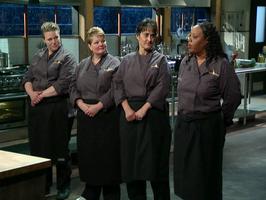Those who know me probably know that I enjoy to cook. I advocate strict adherence to the adage, “I cook with wine, sometimes I even put it into the food.” So, it’s not uncommon to find me in the kitchen, making dinner, with a glass of red wine in my hand. I watch “Chopped” or “Top Chef”, usually some cooking show. These shows often give me ideas or inspirations for things I’d like to try. I should be clear here, I am your basic home cook, I have no delusions of grandeur. I do enjoy food though… so, so much.
This past weekend I was down for the count on Friday and Saturday with an icky cold. It was most depressing as it interfered with my social life and that is a no-no. Saying that I am social is a bit like saying the Cookie Monster enjoys cookies, duh. I curled up on the couch with Katie and we went through the DVR, looking for kid appropriate television as we both banged away on our laptops. We watched a good amount of Chopped. For those of you who don’t know, this is a cooking competition show where four contestants per show are judged on their ability to take crazy ingredients and then elevate them into a cohesive dish. After each round, appetizer, main course and dessert, judges eliminate a contestant until a winner is chosen.
In honor of the implementation of the Healthy Hunger-Free Kids Act, voted on in 2010, but coming into effect this school year, the show featured what they call “school chefs”, or as we know them, “lunch ladies.” These cafeteria cooks were a pleasure to watch. There have been two episodes now, so eight school chefs featured. Many of these women work in low-income areas battling the twin modern-day evils of childhood hunger and childhood obesity (according to USA Today one in three American children is obese http://usatoday30.usatoday.com/news/nation/story/2012/09/28/kids-push-back-on-new-school-lunch/57842204/1). The school cooks themselves are not highly paid, so may be working two or three jobs to make ends meet. Despite their own lack of personal funds, many expressed a wish to take their prize money, should they win the coveted $10,000, and funnel the money, or at least part of it, back into their school.
I was touched by the care and concern these ladies felt toward their students and how convinced each of them was that she could make a meaningful change for the better in the health and lives of the children they fed.
The law decreases the maximum allowed calories on school lunches:
Elementary Grades- old minimum 635, new 550-650 calories
Middle Schoolers- old minimum 750, new 600-700 calories
High Schoolers- old minimum 825 new 750-850 calories
In general the bill looks like this:
New nutrition standards
- Gives USDA the authority to set new standards for food sold in lunches during the regular day, including vending machines.
- Authorizes additional funds for the new standards for federal-subsidized school lunches.
- Provides resources for schools and communities to utilize local farms and gardens to provide fresh produce.
- Provides resources to increase nutritional quality of food provided by USDA
- Increases access to drinking water in schools
- Sets minimal standards for school wellness policies
Increases access
- Increased the number of eligible children for school meal programs by 115,000
- Uses census data to determine student need in high-poverty areas, rather than relying on paper applications.
- Authorizes USDA to provide meals in more after-school programs in “high-risk” areas
Program monitoring
- Requires school districts to be audited every 3 years to see if they have met nutrition standards
- Requires easier access for students and parents about nutritional facts of meals
- Improves recall procedures for school food
- Provides training for school lunch providers
The program seeks not only to decrease the caloric intake of our children, but to change the make up of the meals. Starchy “white” foods like mashed potatoes, tater-tots and macaroni are replaced by more healthy whole grains, fruits and vegetables. These foods have the benefit of more vitamins and minerals as well as a higher fiber content so that students will feel fuller, longer. Children are allowed to go back for seconds, thirds and so on for the fruits and vegetables. Of course, in the way of kids from time immemorial, students are refusing to eat their vegies and then complaining that they are starving by 1:30-2pm. I have the same problem at home, kids.
If you have questions regarding the bill, the Huffington Post just did a nice write-up : http://www.huffingtonpost.com/2010/12/14/child-nutrition-bill-some_n_796112.html#s205959&title=Regulation_Of_Meal
Guest judge Sam Kass did a good job outlining the challenges that these ladies face. They have to cook a lot of food on a little bit of money (approximately $1.25 per student) and still come up with something simultaneously healthy and enticing enough that a student will eat it. Not an easy task! It was a delight to watch these “lunch ladies” at work, their food looked good, too. Not a “mystery meat” in sight!
You can see it yourself on:
http://www.foodnetwork.com/chopped/class-acts/index.html

Kass is a chef at the White House and has been a key advisor in the First Lady’s Let’s Move! campaign to better the health of Americans in general and, specifically, children. Michelle Obama’s White House vegetable garden is the first since Eleanor Roosevelt’s Victory Garden. It has produced over 3,000 pounds of food to date, feeding guests and staff, as well as providing donations to local food banks.
In honor of the delightful School Chefs, I was moved to search for that Adam Sandler (and Chris Farley, of course) classic Lunch Lady Land. Enjoy!
http://www.youtube.com/watch?v=E_-KbstEG4E
